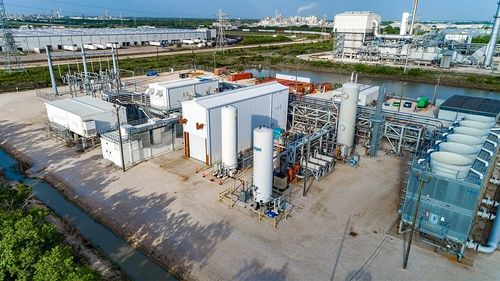Optimizing electrolysis for renewables depends not just on how far you can turn the machine up, but how far you can turn it down.
A consensus is growing around the importance of turndown ratios for electrolyzers, with a variety of use cases for green hydrogen requiring the machines to be run at low levels during periods of high power pricing.
Proton exchange membrane (PEM) electrolyzers are known for their ability to quickly ramp production up and down, but manufacturers of all stripes have begun to tout their technologies’ turndown ratios, with implications for capital costs and the levelized cost of producing hydrogen from renewable power.
Simply put, some electrolyzer plant operators will likely seek to lower hydrogen production during periods of high power pricing, since the cost of electricity is the largest operating expense. But cycling the electrolyzers completely off and on can lead to added system degradation, giving importance to the ability of the machines to run at low levels.
A study from the National Renewable Energy Laboratory (NREL) analyzes a US grid buildout through 2050, noting favorable locations and seasonality for power pricing as something of a guideline for green hydrogen development. The study notes that the lowest achievable turndown ratio is a main factor in minimizing hydrogen levelized cost along with the number of hours a system can operate at that minimum level – something that applies to all types of electrolyzers.
“When you start to look at hourly costs from the data in different locations, you see that all of this renewable buildout is going to create opportunities in given locations where you going to have a lot of renewable generation and not a lot of load on the system and that’s going to drive the cost for that energy down,” said Alex Badgett, an author of the study at NREL.
To be sure, the fast-moving technological environment for electrolysis leaves open the possibility for efficiency gains and disruptive innovation. And a variety of factors – balance of plant, energy efficiency, system degradation – also influence plant economics. But the lowest possible turndown ratios will drive opportunities for green hydrogen developers, Badgett said.
ReSource reviewed available spec sheets for electrolyzer providers and asked every maker of PEM and SOEC systems to detail the turndown capabilities of their machines. Alkaline electrolyzers were left out of the analysis given their more limited load flexibility, as their separators are less effective at preventing potentially dangerous cross-diffusion of gasses. Some manufacturers are fully transparent regarding turndown ranges while others declined to comment or did not reply to inquiries.
‘Not trivial’
In designing projects, developers are analyzing hourly energy supply schedules and pairing the outlook with what is known about available technology options.
“Some electrolyzers like to operate at half power, and others like to operate at full power, and in any given system, you can have between 10 and 50 electrolyzers wired and plumbed in parallel,” said Mike Grunow, who leads the Power-to-X platform at Strata Clean Energy.
“Our thought process even goes down to: let’s say you have to operate the H2 plant at 25% throughput. Do you operate all of the electrolyzers at 25%, or do you turn 75% of the electrolyzers off and only operate 25% at full power?”
The difference in the schemes, he added, is “not trivial as each technology has different efficiency curves and drivers of degradation.”
Different use cases for the hydrogen derivative, meanwhile, lead to different natural selection of technologies, Grunow said, adding that the innovation cycle is now happening every 12 months, requiring a close eye on advances in technology.
Electrolyzer start-up Electric Hydrogen, a maker of PEM electrolyzers, is commercializing a 100 MW system that can turn down to 10%, according to Jason Mortimer, SVP of global sales at the company.
HyAxium, another start-up, can turn its system down to 10%, according to its materials. Norway-based Hystar, which recently announced plans to build a plant in the US, also promotes a 10% turndown ratio.
A more established PEM electrolyzer provider, Cummins, advertises turndown ratios of 5% for its machines. Sungrow Power, a China-based manufacturer, similarly advertises 5% for PEM electrolyzers.
Siemens Energy has a minimum turndown ratio per stack of 40%, but for a single system it can be less in exceptional cases, according to Claudia Nehring, a company spokesperson.
“We focus on large systems” – greater than 100 MW – “and currently consider this value to be appropriate, taking into account the optimization between efficiency, degradation and dynamics, but are working on an improvement,” she said via email.
ITM Power declined to provide details but said its turndown capabilities are “to be expected” for a market leader in this technology. Materials from German-based H-Tec Systems note a modulation rate down to 10%.
Additional PEM makers Nel, Ohmium, Elogen, H2B2, Hoeller Electrolyzer, Plug Power, Shanghai Electric, and Teledyne Energy Systems did not respond to requests for information.
PEM alternatives
Other forms of electrolysis can also ramp dynamically. And some project developers point to PEM’s use of iridium, part of the platinum metals family, as a drawback due to potential scarcity issues.
Verdagy, for example, has developed an advanced alkaline water electrolysis (AWE) system called eDynamic that it says takes the best of PEM and alkaline technologies while designing out the downsides.
The company’s technology “addresses the barriers that limited traditional AWE adoption by using single-element cells that can operate efficiently at high current densities,” executives said in response to emailed questions.
“The ability to operate at very high current densities, coupled with a balance of stack and balance of plant optimized for dynamic operation, allow Verdagy’s electrolyzers to operate across a very broad range spanning 0.1-2.0 A/cm2,” they said.
In other words, the machine can turn down to 5%, part of the design that enables operators “to modulate production to take advantage of time-of-day pricing and/or fluctuations in energy production.”
Meanwhile, German-based Thysenkrupp Nucera, another maker of advanced water electrolyzers, advertises a 10% turndown ratio.
SOEC
A relatively new electrolysis technology, the solid oxide electrolyzer cell has also proven to be capable of low turndown ratios. Solid oxide electrolysis is particularly attractive when paired with high-temperature industrial processes, where heat can be captured and fed back into the high-temperature SOEC process, making it more efficient.
Joel Moser, the CEO of First Ammonia, said he chose SOEC from Denmark-based Haldor Topsoe in part because the machines can be turned completely off with no degradation, as long as you keep them warm.
“Generally speaking we expect to ramp up and ramp down between 100% and 10%,” he said. “We can turn them off as long as we keep them warm, and then we can turn them right back on.”
Still, SOEC systems are not without challenges.
“Low stack power and high operating temperature, which in turn requires more ancillary equipment to operate the electrolyzer, are widely viewed as the main drawbacks of SOEC technology,” according to a report from the Clean Air Task Force, which explores SOEC technology and its commercial prospects. “SOEC systems are also considered to have a shorter operating life due to thermal stress.”
Additional makers of SOEC machines Bloom Energy, Ceres, Elcogen, Genvia, SolydERA, and Toshiba did not respond to inquiries.
At NREL, researchers are watching for more automation and scale in the electrolyzer production process to bring costs down. Increasing efficiency through balance-of-plant improvements is another opportunity to reduce system costs.
In addition, more analysis of how large electrolyzer projects will impact the future electrical grid is required, according to Badgett.
The NREL team modeled the hourly marginal cost at any given time in any location in the US, but the model assumes that the electrolyzer takes energy without impacting the cost of energy.
“When we start to get to gigawatt-scale electrolysis,” he said, “that’s going to significantly impact prices, as well as how the grid is going to build out.”





